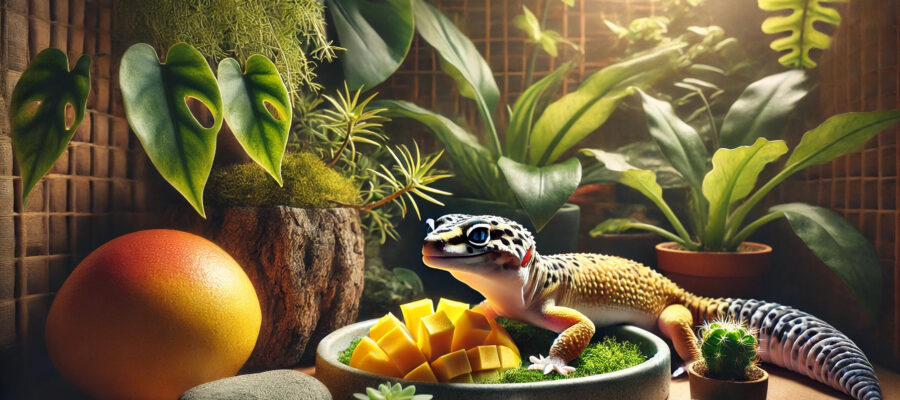Leopard geckos are fascinating reptiles with simple dietary needs. While their primary food source is live insects, many owners wonder if they can offer their gecko plants or fruits as part of their diet. While this isn’t typical, certain safe plants and fruits can occasionally enhance their environment or provide enrichment. Here’s what you need to know.
Can Leopard Geckos Eat Plants and Fruits?
Leopard geckos are insectivores, meaning their primary diet consists of live insects like crickets, mealworms, and dubia roaches. Unlike herbivores or omnivores, leopard geckos don’t require plant matter or fruit for nutrition. However, some safe fruits and plants can be introduced sparingly or used in their terrarium for added enrichment or aesthetic value.
Safe Plants for Leopard Gecko Terrariums
Adding live plants to your gecko’s terrarium can create a naturalistic and enriching environment. However, not all plants are safe. Here are a few safe options:
- Pothos (Epipremnum aureum)
A hardy and easy-to-care-for plant, pothos adds lush greenery to the terrarium. It’s non-toxic and thrives in various conditions, making it ideal for beginners. - Aloe Vera
Aloe vera is not only safe but also visually appealing. Its thick, water-storing leaves are perfect for arid terrarium setups. - Snake Plant (Sansevieria)
Known for its durability, the snake plant is a great option for terrariums. Just ensure your gecko isn’t attempting to chew on it, as it’s not part of their natural diet. - Succulents
Certain succulents like haworthia or echeveria are safe and mimic the leopard gecko’s native arid environment. Avoid cacti with sharp spines to prevent injuries.
Live plants can also help regulate humidity, but be cautious to avoid excessive moisture, which can lead to respiratory issues. Learn more about humidity levels for leopard geckos.
Fruits Leopard Geckos Can Occasionally Try
While fruits aren’t necessary, they can occasionally be offered in tiny amounts as a treat or for enrichment. Here are a few safe options:
- Mango
Soft and easy to digest, mango pieces can be a rare treat. - Papaya
Papaya is a tropical fruit that’s high in water content. Offer it sparingly and in tiny pieces. - Blueberries
These small fruits can be a fun, occasional offering. Mash them slightly to make them easier for your gecko to interact with. - Watermelon
Rich in hydration, watermelon is another safe choice but should be given in minuscule amounts due to its sugar content.
Important Note: Always offer fruits in moderation and remove uneaten pieces promptly to prevent bacterial growth in the enclosure. Fruits are not a dietary staple and should only be considered a form of enrichment.
What to Avoid
Not all plants and fruits are safe for leopard geckos. Avoid these at all costs:
- Toxic Plants: Ivy, philodendrons, or lilies.
- Citrus Fruits: Oranges, lemons, and grapefruits are too acidic.
- Sticky or Sugary Fruits: Avoid bananas, as their sticky texture can pose a choking hazard.
If you’re unsure about a plant or fruit, it’s better to leave it out. Learn more about creating a safe habitat for your gecko.
How to Introduce Plants and Fruits Safely
- Choose Wisely
Stick to the recommended safe plants and fruits listed above. - Clean Thoroughly
Wash all plants and fruits to remove pesticides or contaminants. - Monitor Your Gecko
Observe how your gecko interacts with the plants or fruits. Remove them if they show disinterest or if the items spoil. - Use Live Plants as Decoration
Remember, plants in the terrarium are primarily for aesthetic and environmental benefits, not for eating.
Final Thoughts
While leopard geckos don’t need plants or fruits in their diet, introducing safe options can provide enrichment and beautify their environment. By choosing non-toxic plants like pothos or aloe vera and offering fruits like mango occasionally, you can create a vibrant and stimulating space for your gecko.
Ready to learn more about leopard gecko care? Explore our Feeding Guides for additional tips and advice.
Get Your Free Leopard Gecko Care Checklist!
Are you ready to give your leopard gecko the best care possible? Download our FREE PDF e-book featuring a comprehensive care checklist!
This handy guide covers everything from habitat setup to feeding and health tips, ensuring your gecko thrives.
👉 Download your checklist now!




